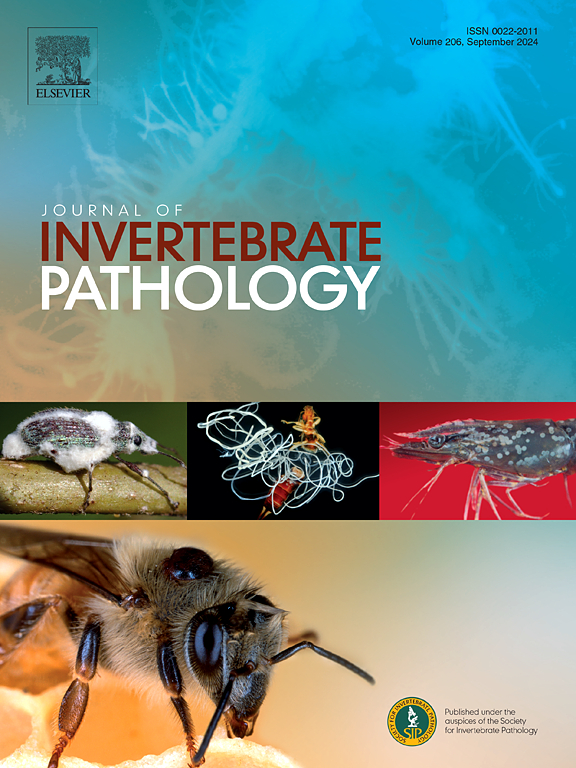RNA metagenomics revealed insights into the viromes of honey bees (Apis mellifera) and Varroa mites (Varroa destructor) in Taiwan
IF 2.4
3区 生物学
Q1 ZOOLOGY
引用次数: 0
Abstract
The honey bee (Apis mellifera) is a vital pollinator for crops. However, they are infested by an ecto-parasite that has spread worldwide, Varroa mite (Varroa destructor). The Varroa mite is a vector of various western honey bee viruses. In this study, the prevalence of seven honey bee viruses (Deformed wing virus, Lake Sinai virus, Acute bee paralysis virus, Sacbrood virus, Kashmir bee virus, Black queen cell virus, Israeli acute paralysis virus), was screened with the honey bees, which were collected from fourteen apiaries from March 2023 to January 2024, and the Varroa mites, which were collected from two apiaries from July to October 2023 by using RT-PCR. Subsequently, metagenomic analyses were conducted on seven honey bee samples and two Varroa mite samples using next-generation sequencing with poly-A capture and rRNA depletion library construction methods. The results showed that 50% to 85.7% of honey bee viruses in each sample were detected by both methods, with up to three additional viruses identified when combining the two approaches. These findings underscore the importance of integrating both methods for comprehensive virome analysis. According to the virome analysis, 28 honey bee viruses were identified in honey bees and 11 in Varroa mites. Among these, 23 viruses were newly recorded in Taiwanese honey bee populations. Notably, three of the newly recorded viruses, Acute bee paralysis virus, Israeli acute paralysis virus, and Apis mellifera filamentous virus, are known to cause symptoms in honey bees, posing potential risks to their health. Six of these viruses were also detected in Varroa mites, highlighting their role in viral transmission. This study represents the first virome analysis of honey bees and Varroa mites in Taiwan, providing critical insights into honey bee health and establishing a foundation for future health assessment indices and mitigation strategies.

RNA宏基因组学揭示了台湾蜜蜂(Apis mellifera)和瓦螨(瓦螨)的病毒组
蜜蜂(Apis mellifera)是农作物重要的传粉者。然而,它们被一种已经在世界范围内传播的寄生虫——瓦螨(瓦螨破坏者)所感染。瓦螨是各种西方蜜蜂病毒的载体。本研究采用RT-PCR方法,对2023年3月~ 2024年1月采集的14个蜂房的蜜蜂和2023年7月~ 10月采集的2个蜂房的瓦螨进行了7种蜜蜂病毒(畸形翼病毒、西奈湖病毒、急性蜂麻痹病毒、Sacbrood病毒、克什米尔蜂病毒、黑后细胞病毒、以色列急性麻痹病毒)的检测。随后,采用聚a捕获和rRNA枯竭文库构建新一代测序方法,对7份蜜蜂样本和2份瓦螨样本进行宏基因组分析。结果表明,两种方法在每个样本中均检测到50% ~ 85.7%的蜜蜂病毒,两种方法联合检测到的病毒最多可达3种。这些发现强调了整合两种方法进行全面病毒分析的重要性。根据病毒组分析,在蜜蜂中鉴定出28种蜜蜂病毒,在瓦螨中鉴定出11种。其中,台湾蜜蜂种群新发现23种病毒。值得注意的是,新记录的三种病毒,即急性蜜蜂麻痹病毒、以色列急性麻痹病毒和蜜蜂丝状病毒,已知会引起蜜蜂的症状,对它们的健康构成潜在风险。其中6种病毒也在瓦螨中检测到,突出了它们在病毒传播中的作用。本研究首次对台湾地区的蜜蜂和瓦螨进行了病毒组分析,为了解蜜蜂的健康状况提供了重要的见解,并为未来的健康评估指标和缓解策略奠定了基础。
本文章由计算机程序翻译,如有差异,请以英文原文为准。
求助全文
约1分钟内获得全文
求助全文
来源期刊
CiteScore
6.10
自引率
5.90%
发文量
94
审稿时长
1 months
期刊介绍:
The Journal of Invertebrate Pathology presents original research articles and notes on the induction and pathogenesis of diseases of invertebrates, including the suppression of diseases in beneficial species, and the use of diseases in controlling undesirable species. In addition, the journal publishes the results of physiological, morphological, genetic, immunological and ecological studies as related to the etiologic agents of diseases of invertebrates.
The Journal of Invertebrate Pathology is the adopted journal of the Society for Invertebrate Pathology, and is available to SIP members at a special reduced price.

 求助内容:
求助内容: 应助结果提醒方式:
应助结果提醒方式:


